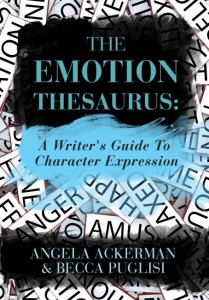Who Are You: Characters That Stand Out To Readers by Angela Ackerman
Today, I’m delighted to welcome Angela Ackerman to the blog. She’s an insightful writer and blogger who is the coauthor of The Emotion Thesaurus: A Writer’s Guide to Character Expression. In today’s tip, she talks about how you can create characters that hook a reader’s heart. (And check out below how you can win an electronic copy of The Emotion Thesaurus.)
Who Are You: Characters That Stand Out To Readers by Angela Ackerman
 There has always been a debate on what is more important–plot or characters. For a long time, I stood on the PLOT side of things, because I felt that it was my cool plot twists and turns that kept readers glued to the page. Characters were just the people populating my world, the ones I did things to for the to story work.
There has always been a debate on what is more important–plot or characters. For a long time, I stood on the PLOT side of things, because I felt that it was my cool plot twists and turns that kept readers glued to the page. Characters were just the people populating my world, the ones I did things to for the to story work.
And, well, I was wrong.
The more I thought about what makes a great read, the more I came back to characters. If you think about the stories you loved and the books that made you forget to eat or workout or walk the dog…what about them stays with you? Do you wish you could read more of the same plot, or more of the characters?
I’m not saying that plot and world building aren’t important, because they are. But it is the characters readers connect to and root for, and this happens because of one very important word: EMPATHY.
When characters are unique, well-rounded and familiar in some way, we connect with them. We empathize with what they are going through, become tense when trouble hits and relax when they emerge in one piece. We care what happens to them, because our emotions are engaged.
So how do we build strong characters that command our attention?
Create Empathy Through Action, Not Circumstance
Some writers try to use hardship as a way to elicit reader empathy: characters who are kicked around, impoverished, have some sort of physical disability or handicap. Stories start out with dead parents, being moved across the country, losing a job or discovering a spouse was cheating. At times, this technique can have an overused feel if it touches on a too-common plot theme (like moving to a new town in Middle Grade or YA Fiction). Readers might feel sympathy for what the character is dealing with, but they might also grow bored or impatient because they have seen this scenario before.
What pulls a reader in and makes them care is to see how the character acts despite hardship. The actions that they take regardless of their circumstances is what we find compelling. If a character is a frazzled mess after discovering his spouse gone and a Dear John note dropped on his nightstand, and yet he manages to shove hurt aside and make his shift at the TeenDistressCallCenter, that makes us care. That is what causes us to root for him.
Understand What Came Before
The character’s life did not begin on page one, so we need to spend some time thinking about their past. What events and traumas shaped them? What happened to them that left them feeling utterly helpless and weak? Who let them down in life, and who built them up? What marked them, wounded them? How do these past events now influence their personality and behavior?
We all try to avoid the hurts of the past, and to keep bad things from repeating. Thinking about who and what hurt your character will help you understand how they behave now to emotionally protect themselves.
Give Them Flaws, Self Doubt & Let Them Make Mistakes
People are unique, and characters must be as well, but that doesn’t mean they should be foreign to the reader. We are all flawed and expect to see faults in others. If a character is too perfect and too confident, they won’t feel real. Showing a character’s shortcomings makes them feel more authentic and rounded. We empathize when we see another’s flaws and watch them make mistakes. It is a reminder of our own imperfections.
YOUR TURN! How do you create complex characters worth rooting for? What ways do you help them to stand out to readers? Tell me in the comments!
 About the author. Angela Ackerman is a Canadian who writes on the darker side of Middle Grade and Young Adult. A strong believer in writers helping writers, she blogs at the award winning resource, The Bookshelf Muse and is co-author of The Emotion Thesaurus: A Writer’s Guide To Character Expression. Angela is represented by Jill Corcoran of The Herman Agency.
About the author. Angela Ackerman is a Canadian who writes on the darker side of Middle Grade and Young Adult. A strong believer in writers helping writers, she blogs at the award winning resource, The Bookshelf Muse and is co-author of The Emotion Thesaurus: A Writer’s Guide To Character Expression. Angela is represented by Jill Corcoran of The Herman Agency.
About the book: The Emotion Thesaurus: A Writer’s Guide to Character Expression is a writer’s best friend, helping to navigate the challenging terrain of showing character emotion. This brainstorming tool explores seventy-five emotions and provides a large selection of body language, internal sensations, actions and thoughts associated with each. Written in an easy-to-navigate list format, readers can draw inspiration from character cues that range in intensity to match any emotional moment.
a Rafflecopter giveaway









The book I’m writing right now the MC touches a pink heart necklace when she needs comfort. She mistakenly thinks it her mothers, who is dead. I love your site here. I come back often when I’m looking for a physical response to an emotion. Thanks for all you do here!
Taffy, I love that. It makes me wonder what she will do when she discovers it isn’t her mother’s, and why she thinks it is. Great detail to set her apart–it tells us important things about her!
That is a great visual. Even if you don’t always say that she is upset, or specifically needing that comfort, that image conveys that.
Great post! I appreciate this, Angela, thank you. Have been thinking about this in light of a current read, and of course, the WIP, so I appreciate the insight.
Karen, glad it helps. It feels good to explore characters more fully as for me, this has always be a struggle. I love sharing what I learn. 🙂
Love this line “What pulls a reader in and makes them care is to see how the character acts despite hardship.”
A great tip and reminder!
Thanks so much, Sabrina!
I give my characters one dominant trait, either a strength or weakness, and then make that trait become either a crutch or a saving grace somewhere in the story. Easier said than done, that’s for sure.
Love this post; thanks for the interview.
That’s a smart way to go about it. Traits and flaws are in place to protect us, but in a novel, the character has to grow and change in order to satisfy the arc, and so we need there to be personality conflicts within our characters, so they can overcome what’s holding them back.
Yes! Characters matters most. As a reader, I want to sympathize not only with a character’s situation, but how they react to it.
Yes, this is really what pulls us in as readers–not the hardship, but how a character faces that hardship!
I love plot driven stories but they have to come with sympathetic characters I can relate to. Thanks for sharing the tips on how to make them stand out. So true that you shouldn’t rely on just difficult situations like homelessness to make us care about them.
I love awesome plots as well, Natalie, and I think this is why it took me so long to fully understand the importance of characters. The best books are ones where the author excels at both plot and character!
One of my favorite pieces of advice given to me by my agent is to imagine that every secondary character is the main character of their own story. I love that because it reminds me that fleshing out the secondary guys is always as important as fleshing out the main character.
This is really great advice! I often find myself that secondary characters are easier to write, because we can flesh them out without as much pressure. It allows me to feel more creative, I think!
You’re so right, Angela!! It’s always the characters that keep us coming back for more!!
Hi Traci! Thanks for stopping in! 🙂
I always love what Angela has to say. I am writing a series that has a lot of action in it, but without the characters driving the action, without the angst, hardship and turmoil (and more importantly, what caused it and how they respond to it), it would just be words moving by rather quickly on the page. I think sometimes writers might do these things inately, without realizing what they’re doing. I think othertimes, when their writing falls flat, that’s what they’re missing. Great job putting into words what we all need to hear.
Very well said, and thank you! Glad this post resonated!
It took me a long time to really come around to characters, and I think it was because I always felt mine were weak–nameless actors in a play that had a bigger message, a bigger theme. I know this is flawed thinking, and I am enjoying learning more about what makes a character tick as I try to write stronger, authentic characters.
Angela, this is such great advice. I still have so much to learn, and character is definitely one area where I need work.
I have a lot to learn as well–so glad this post will help you, Julie! Happy writing!
I try very VERY hard to make my characters real to myself and the people I have known in my own life. I try to share the ups AND the downs of their day to day life as well as the internal monologue and struggles they face. I share their doubts and fears along with their triumphs and joys. I hate reading a book where a character is Totally Pollyanna or Terribly Awful All The Time. Almost no one in the world is all one thing all the time.
Pingback : 3 Quick Tips To Help Readers Connect To Your Hero - WRITERS HELPING WRITERS™WRITERS HELPING WRITERS™
Angela, this is priceless:
“What pulls a reader in and makes them care is to see how the character acts despite hardship. The actions that they take regardless of their circumstances is what we find compelling.”
Pingback : Character in Characters | DL Fowler's Blog